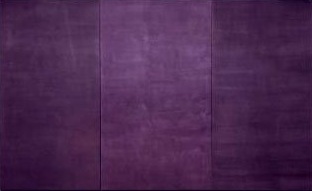
The new Jacaranda season began last night with a concert that almost filled the church and brought out the Los Angeles Times critic, with photographer as well. The program comprised three key works from the 70s: Morton Feldman‘s Rothko Chapel from 1971, Ben Johnston‘s Quartet No. 4 “Amazing Grace” from 1973, and Philip Glass‘ Einstein on the Beach: Five Knee Plays from 1976. God, it was a gorgeous concert.
I didn’t want the performance of Rothko Chapel to end, but it did, and too soon, coming in at less than 25 minutes. The spaces between notes could have been a bit longer, and some of the notes could have hung in the air a bit longer. The three instrumentalists were Alma Lisa Fernandez on viola, Aron Kallay on celesta, and Kenneth McGrath on percussion, and they seemed to breathe the sounds. A group of local singers billed as the Jacaranda Chamber Singers risked all of those exposed pitches, and they handled all the challenges. This was a great experience.
Few works could follow something like the Feldman, but Johnston’s “Amazing Grace” could do so, and fortunately it took a little while to remove the instruments and risers to give some space between the two. The Denali Quartet now plays this work with seeming ease; perhaps they’ll make it their calling card, as the Phil under Salonen made the Rite of Spring. But the Johnston quartet leaves me wanting more; perhaps the Denalis could expand their Johnston offerings. Or perhaps Monday Evening Concerts could give us a Johnston evening.
The Jacaranda series has recovered the “Five Knee Plays” from Einstein on the Beach, with approval of Glass and the publisher. At the time of their first presentation of the set, in 2005, only the middle work was available; three other segments had been issued for children’s chorus but were no longer available, and the opening segment had been withdrawn and had to be reconstituted. Jacaranda has given us the full set, with pipe organ instead of electronic keyboard, with mixed chorus, with children’s chorus (the Los Angeles Children’s Chorus, of all riches) for the final set, with violin (the violinist of the Denali Quartet) and with three narrators, including Gail Eichenthal and Sandra Tsing Loh of NPR broadcasts. The music still grabs at you.
Jacaranda’s next Santa Monica concert, November 14, serves as an introduction to the Phil’s exciting new “West Coast Left Coast” series with music by John Adams, Ingram Marshall and Lou Harrison. Better get your tickets.
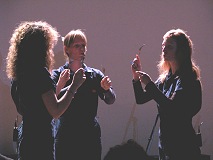 Tuesday evening (27 Oct.) in Princeton’s Taplin Auditorium vocalists Sarah Paden, Anne Hege and Lainie Fefferman — otherwise known as
Tuesday evening (27 Oct.) in Princeton’s Taplin Auditorium vocalists Sarah Paden, Anne Hege and Lainie Fefferman — otherwise known as 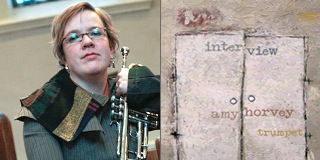 The next evening (28 Oct.), up and across the border to Montreal, Quebec, our tremendously-talented, trumpet-playing web pal
The next evening (28 Oct.), up and across the border to Montreal, Quebec, our tremendously-talented, trumpet-playing web pal  Doug’s work straddles a line between the categories of music, sculpture, and dance and theater.
Doug’s work straddles a line between the categories of music, sculpture, and dance and theater.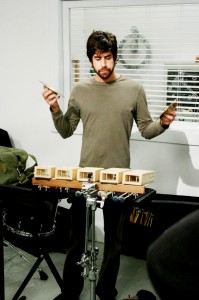
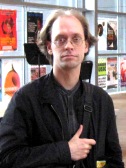 Many of our regular s21 readers should be familiar with Amsterdam’s own
Many of our regular s21 readers should be familiar with Amsterdam’s own 


 For a lot of you Vancouver, British Columbia is one of those “way out there” places. But coming from its U.S. “way out there” sister Seattle, I know that the art and music scenes are anything but moribund (though the Canadian government seems
For a lot of you Vancouver, British Columbia is one of those “way out there” places. But coming from its U.S. “way out there” sister Seattle, I know that the art and music scenes are anything but moribund (though the Canadian government seems  Many of us can recall a time, back in the day, when we brought cups of strong coffee to class and heard a professor tell us about the distant early days of “new music”. Long, long ago, in a galaxy far, far away (Italy),
Many of us can recall a time, back in the day, when we brought cups of strong coffee to class and heard a professor tell us about the distant early days of “new music”. Long, long ago, in a galaxy far, far away (Italy),  (UNTITLED), an original film satire of New York’s avant-garde art scene, will appear in theaters across the nation this fall. By poking fun at the idiosyncrasies of 21st century Bohemia, (UNTITLED) introduces American audiences to some of the best that contemporary art has to offer, notably a score by Pulitzer Prize-winning composer
(UNTITLED), an original film satire of New York’s avant-garde art scene, will appear in theaters across the nation this fall. By poking fun at the idiosyncrasies of 21st century Bohemia, (UNTITLED) introduces American audiences to some of the best that contemporary art has to offer, notably a score by Pulitzer Prize-winning composer